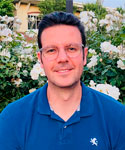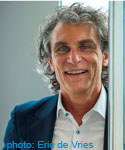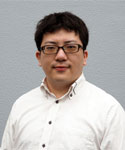 Charles W. Tobias Young Investigator Award
Charles W. Tobias Young Investigator Award
Understanding Reactivity at Electrode-Electrolyte Interfaces in Li-O2 and Li-ion Batteries
By Bryan McCloskey
Bryan McCloskey is Associate Professor and Vice Chair of Graduate Education in the Department of Chemical and Biomolecular Engineering at the University of California, Berkeley (Cal), US. He holds a joint appointment as Faculty Engineer in the Energy Storage and Distributed Resources Division at Lawrence Berkeley National Laboratory (LBNL). McCloskey, a native Coloradoan, received his BS in Chemical Engineering from the Colorado School of Mines, US, in 2003. Andy Herring and Tom McKinnon advised his research on understanding pyrolysis of biomass char. At Benny Freeman’s group at the University of Texas at Austin, US, McCloskey developed anti-fouling coatings for water purification membranes. After completing his PhD in 2009, he was a postdoc and then promoted to Research Staff Member at IBM Almaden Research Center, where he worked on elucidating the electrochemistry of Li-O2 batteries. Since joining Cal and LBNL in 2014, his laboratory has focused on metal-air batteries, photoelectrochemical CO2 reduction, and challenges facing Li-ion batteries, including high voltage cathode stability, advanced cathode material development, extreme fast charging, and low temperature and high transference number electrolyte formulations. He co-authored more than 100 articles, holds six patents, and has won numerous awards including an NSF CAREER Award and the 2015 VW/BASF Science Award- Electrochemistry.
 Edward Goodrich Acheson Award
Edward Goodrich Acheson Award
From Medical Applications to the Environment:
The Important Role of Electrochemical Energy Storage
By Esther Takeuchi
Esther Takeuchi is SUNY Distinguished Professor and William and Jane Knapp Chair in Energy and the Environment at Stony Brook University, US. She holds a joint appointment at Brookhaven National Laboratory as Chair of the Interdisciplinary Science Department. Takeuchi received a BA from the University of Pennsylvania, US, with a double major in chemistry and history, and a PhD in Chemistry from the Ohio State University, US.
Prior to her academic appointments, Takeuchi worked at Greatbatch, Inc., where her achievements in lithium battery research, particularly for implantable applications, led to several technological innovations. Her work was instrumental in the successful development of the lithium/silver vanadium oxide (Li/SVO) battery, the power source of life-saving implantable cardiac defibrillators (ICDs). A prolific inventor, Takeuchi has over 150 patents.
Takeuchi’s accomplishments have been widely recognized. President Obama awarded her the National Medal of Technology and Innovation. Takeuchi was inducted into the National Inventors Hall of Fame, and is a Charter Member of the National Academy of Innovation. She received the E. V. Murphree and Astellas Awards from the American Chemical Society, and the Electrochemical Society (ECS) Battery Division Technology Award. She is a member of the National Academy of Engineering, Fellow of The Electrochemical Society, American Institute of Medical and Biological Engineering, and American Association for the Advancement of Science. She received the European Inventor Award for non-EPO countries (2018), Walston Chubb Innovation Award from Sigma Xi (2019), and an honorary Doctorate in Engineering from Notre Dame University, US. She is past President of the Society.
 Vittorio de Nora Award
Vittorio de Nora Award
From the 237th ECS Meeting
Analysis of the Catalyst Requirements with Regards to Catalyst Structure and Catalyst Durability Studies for PEM Water Electrolysis
By Hubert Gasteiger
Hubert Gasteiger received his PhD in Chemical Engineering from the University of California, Berkeley (UC Berkeley, US, 1993), working with Elton Cairns, Phil Ross, and Nenad Marković. He completed postdoctoral studies at Lawrence Berkeley National Laboratory with Phil Ross and Nenad Marković (1994–1995), and Universität Ulm, Germany, with Jürgen Behm (1996–1998). Gasteiger joined the GM/Opel fuel cell program (Honeoye Falls, US) as Technical Manager (1999–2007), leading the development of catalysts and membrane electrode assemblies. In 2009, he was Visiting Professor at the Massachusetts Institute of Technology (MIT) with Professor Yang Shao-Horn. Appointed Chair of Technical Electrochemistry in 2010 at the Technische Universität München, Germany, his group develops materials, electrode designs, and diagnostics for PEM fuel cells/electrolyzers and lithium ion batteries. He published 202 refereed articles (H-index 74), 15 book chapters, 38 patent applications/patents, and served as Editor-In-Chief for Wiley’s Handbook of Fuel Cells (2003 and 2009).
In 2004, Gasteiger received the International Society of Electrochemistry Klaus-Jürgen Vetter Award, and was promoted to Technical Fellow at General Motors. Named Fellow of The Electrochemical Society (ECS) in 2011, he received the ECS Grove Medal (2012), Physical and Analytical Electrochemistry Division David C. Grahame Award (2015), and the Energy Technology Division Research Award (2017). Gasteiger delivered the 2018 Jacobus van’t Hoff Lecture of the Process Technology Institute at Delft University of Technology, Netherlands. Since 2017, he has served as member of the European Union’s Scientific Committee Fuel Cell and Hydrogen Joint Undertaking.
 Norman Hackerman Young Author Award
Norman Hackerman Young Author Award
Takanori Akita is a PhD student at the Tokyo University of Science, Japan, where he received his BS and MS in Mechanical Engineering. His graduate work under the guidance of Masanori Hayase focuses on copper electrodeposition for a through silicon via (TSV) filling. To observe the behavior of additives in copper electroplating, Akita developed a microfluidic device in which flow cell experiments and rapid switching of the plating solution are enabled. Together with this microfluidic device, in situ optical microscopic observation of the plating surface is also possible. Using this device, the behavior of typical suppressing agents was investigated, and some parameters useful in mathematical modeling of the bottom-up filling were estimated.
Prior to pursuing his PhD, Akita worked as a development engineer at Panasonic Eco Solutions Networks Co., Ltd.
 Bruce Deal & Andy Grove Young Author Award
Bruce Deal & Andy Grove Young Author Award
Takashi Matsumae received his PhD in Engineering from the University of Tokyo, Japan, in 2017. He was then appointed Researcher in the Research Center for Ubiquitous MEMS and Micro Engineering at the National Institute of Advanced Industrial Science and Technology, Japan. Matsumae joined the Device Technology Research Institute there in the spring of 2020. His interests focus on hetero integration using wafer bonding techniques to design future electronic devices. In particular, he and co-workers are currently researching direct bonding techniques of device and heat spreader having high thermal conductivity—such as Cu, AlN, and diamond— for efficient heat dissipation. In addition, as the room-temperature bonding of device and Cu substrates enables electrical connections even on substrates with low thermal resistance—such as PET and paper—they are now studying the feasibility of their bonding technology for flexible electronics.




